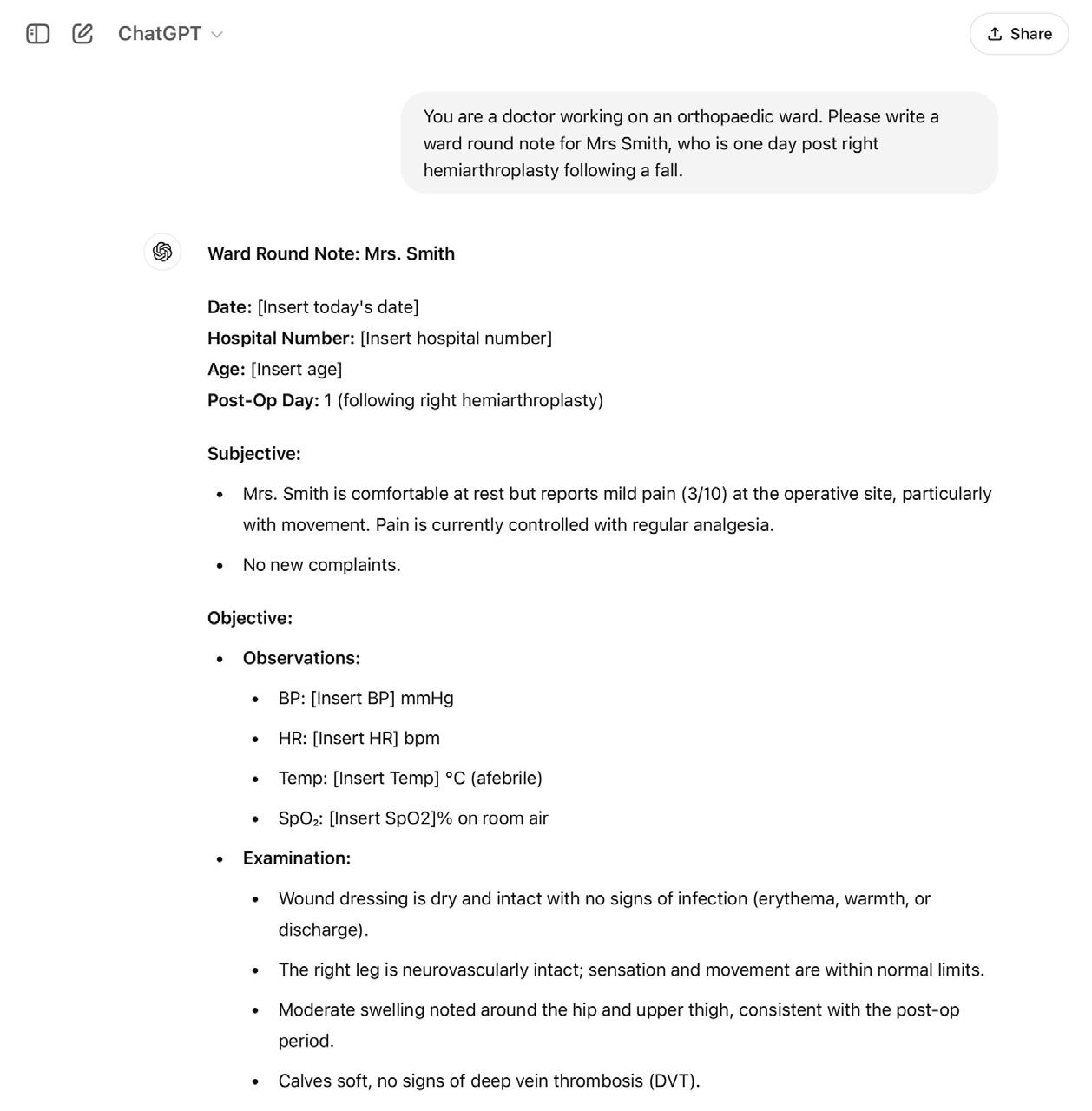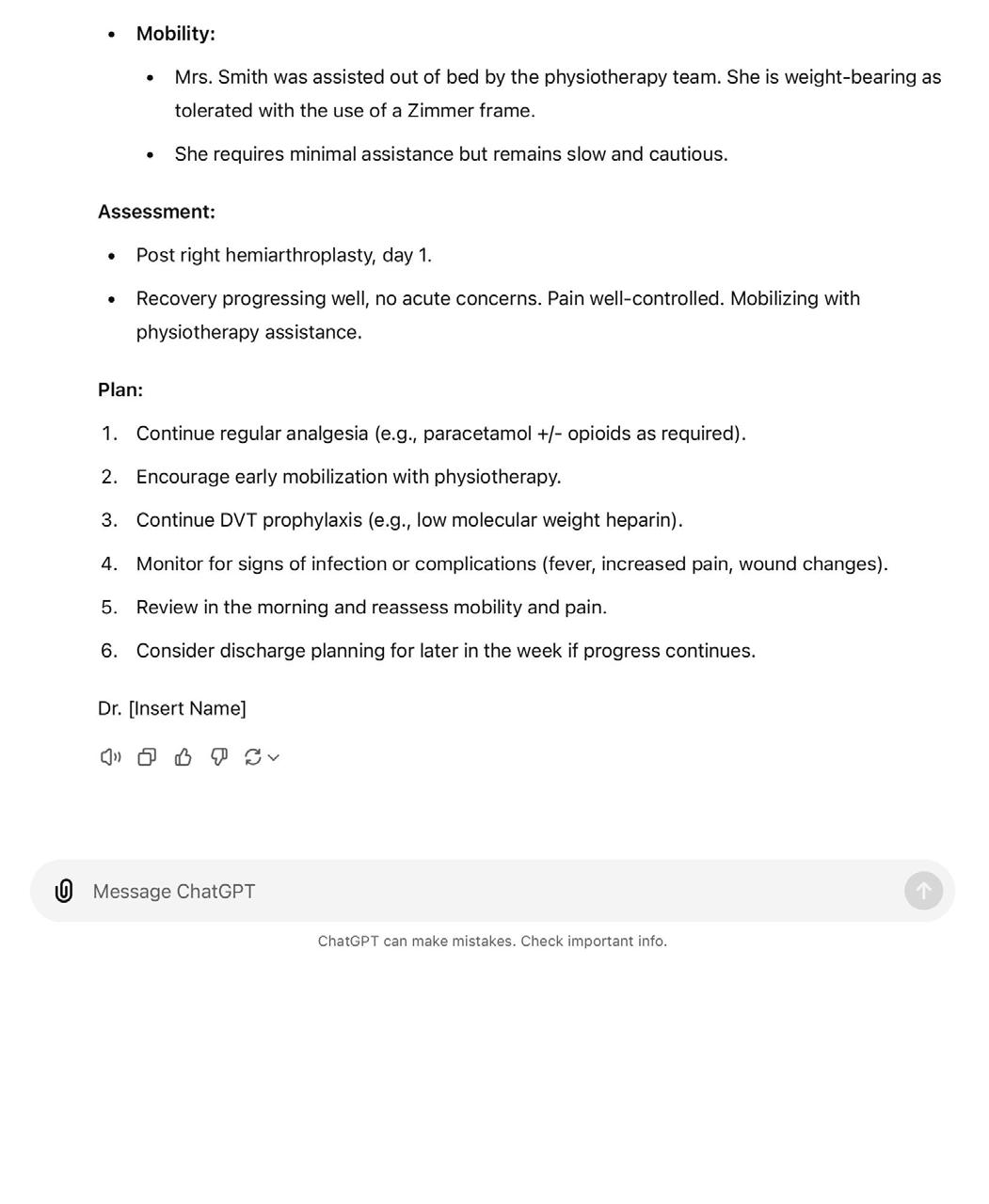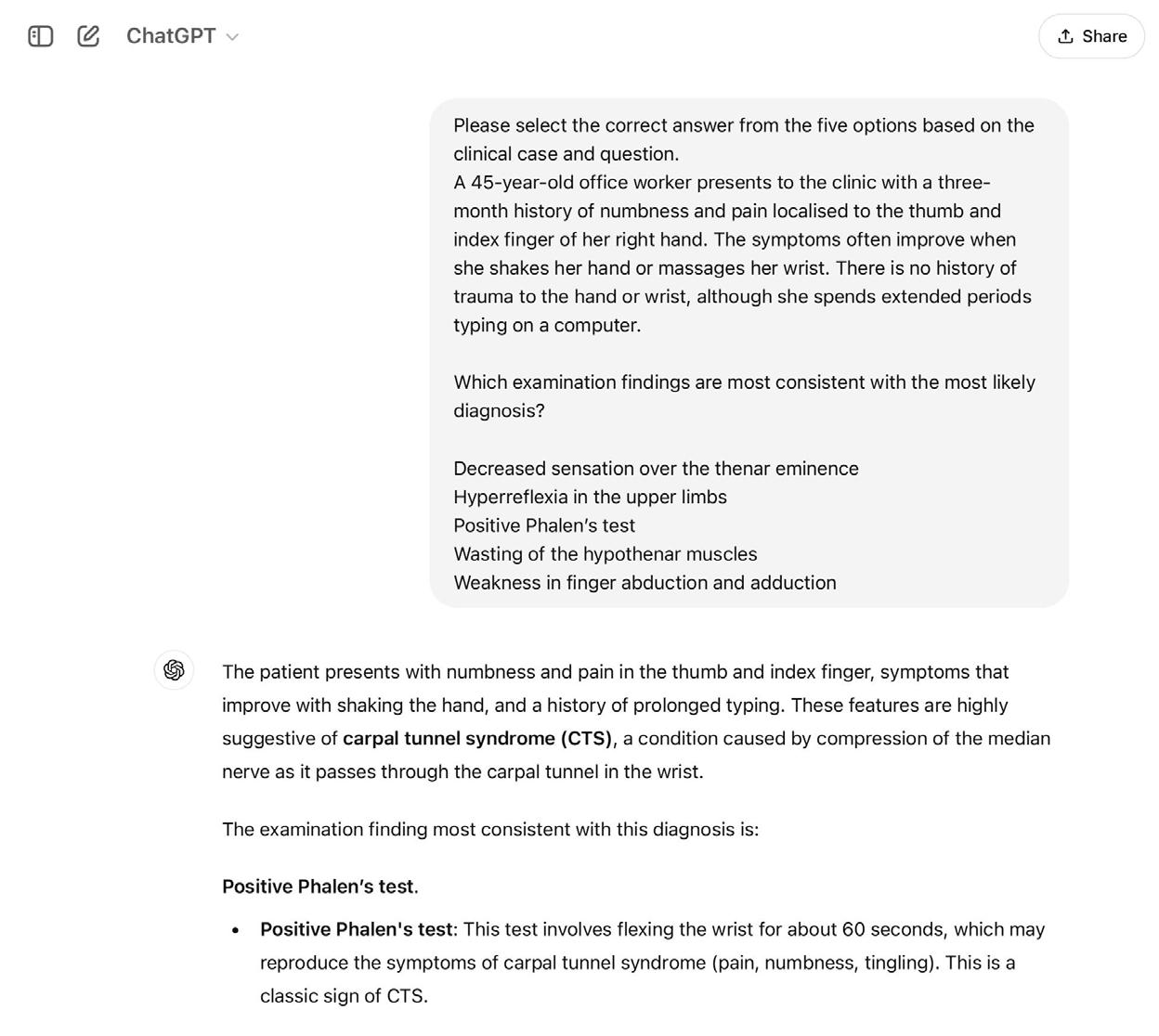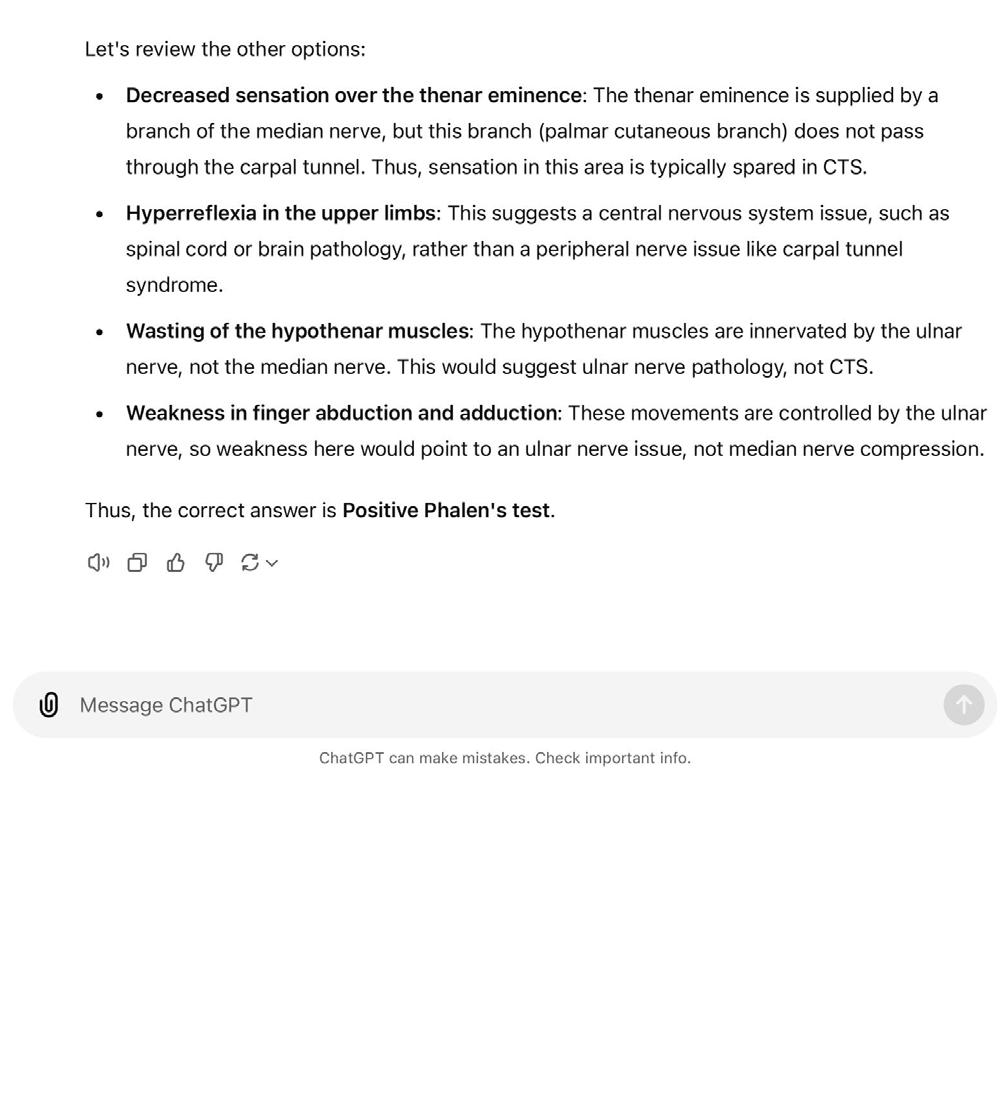
11 minute read
Large language models in upper limb surgery: A narrative review
Catherine Simister, Kyle Lam, Andrew Yiu and James M Kinross
Adoption of large language models (LLMs) has grown exponentially throughout society, and the most well-known of these is ChatGPT (OpenAI, San Francisco, CA, USA). Since in its launch in 2022, it now averages 100 million weekly users [1,2]. LLMs represent a form of artificial intelligence (AI) that are capable of understanding and generating human-like text [3,4].
While the workings of LLMs are more complex than this description, in its simplest form, these models work by predicting the next word in a phrase. If a human is asked to complete the sentence, ‘Humpty Dumpty sat on a’, they would most likely say ‘wall’ and LLMs perform a similar task in reading the input text and predicting what word is most likely to follow it. The input or ‘prompt’ (Table 1) to a LLM can similarly turn this next-word prediction mechanism into a question answering machine, for example, ‘The nerve innervating the biceps brachii muscle is…’.
When confronted by this, the LLM must predict what word would come next through the generation of probabilities for possible next words based on patterns from the data it was trained on and the selection of the highest probability word. Here, the model might output a probability of 95% for musculocutaneous, 2% for radial, and 1% for median and therefore select musculocutaneous.
The power of these models lies in the fact that LLMs learn this next word prediction through the recognition of patterns in enormous quantities of textual data. Commonly available LLMs on the market (Table 2) are likely to have been trained across the majority of textual data available on the internet including internet forum discussions and Wikipedia via a process called self-supervised learning. Differing from supervised learning, where the model would learn that a picture was that of a cat because it had been annotated by a human as a cat, in self-supervised learning the model would guess ‘Dumpty’ if ‘Humpty’ was inputted and then compare this prediction with the actual word contained within the training data. If correct, the model then updates the variables within the model or ‘parameters’ so that it is more likely to predict this the next time. The model subsequently looks at ‘Humpty Dumpty’ and tries to predict the third word in the sentence by repeating the same process.
The speed of societal AI adoption has been driven in part by the increase in computing power for the training of generative AI based models, which is climbing fourfold each year, and by novel developments in AI architectures. AI capable of creating original content, such as these models, are termed ‘generative AI’ and can output text, images, video, and audio, from minimal input data [5,6]. Generative AI has seen rapid uptake across multiple industries including the financial sector for report writing and within retail for online chatbot services [7] and this has been reflected within its growth within the market having been estimated to be worth over $1 trillion by 2032. It is therefore little surprise that healthcare has also been a proposed target for LLMs [8,9]. This review sets out prospective uses and benefits of LLMs within healthcare, with a focus on upper limb surgery, describes envisaged challenges to clinical translation, and future targets for research.
LLMs encode clinical knowledge
LLMs have been found to encode significant clinical knowledge, with ChatGPT 3.5 either meeting or achieving close to the pass mark in all three steps of the US Medical Licensing Exam (USMLE) [10-12]. Within postgraduate examinations, LLMs have also passed the Member of the Royal College of Surgeons (MRCS) exam, scoring more than 85% [12]. LLMs, such as MedPaLM and PubMedGPT, which have been specifically fine-tuned on medical datasets may enhance the trustworthiness of ‘out-of-the-box’ models and may demonstrate further promise for the use of LLMs within clinical practice [13,14].
One proposed clinical application for LLMs within the literature are for LLMs to act as co-pilots for diagnosis and management. Within upper limb surgery, Google’s Gemini correctly classified 70% of hand injuries from a series of textbook vignettes [15] and Daher et al found ChatGPT 3.5 correctly diagnosed 93% of shoulder and elbow complaints, but relied heavily on MRI reports [16]. ChatGPT’s diagnostic success was, however, not replicated when presented with more complex cases, such as patients with comorbidities or uncommon injuries [16,17]. For example, ChatGPT 3.5 was unable to diagnose an atypical radial nerve injury where the sensory impairment differed from the conventional pattern [17]. Whilst models themselves are limited by the data they are trained upon, they are also limited by the input or ‘prompt’ they are given. Limitations of these models will likely be improved upon with future technological iterations which will likely see an exponential growth in model size.
LLMs for improved clinical efficiency
LLMs have also been proposed to improve clinical efficiency allowing time to be more effectively dedicated to direct patient care [18]. One potential application is within triage, where LLMs could facilitate clinical decisionmaking and automatically streamline patients to the correct services at presentation [19-20]. Newer iterations of LLMs, which allow processing of multimodal input, such as radiographic images, open significant avenues for their wider use, especially within orthopaedic surgery [21,22].
Beyond direct clinical use, the capability of LLMs to automatically generate text often indistinguishable from that authored by humans could see them alleviating the high administrative burden of clerical work for junior doctors, who are estimated to spend approximately 50% of their time completing these tasks [23], (Figure 1).


Patel and Lam found that ChatGPT was able to produce a discharge summary when provided with a short clinical vignette, suggesting LLMs may be useful in reducing the time taken to complete these tasks [24]. However, such applications must be balanced with the need to maintain patient confidentiality, which can limit the capability of LLMs both within the training and inference process [25].
LLMs for education
There are significant challenges ahead of translation of LLMs for direct clinical applications, including quality assurance, trustworthiness, and security. Education, however, is a potentially low-risk, high-reward setting for the use of LLMs, which could breach the gap prior to their wider clinical use. For example, LLMs could assist with simulating patient-doctor scenarios, creating study plans, exploring concepts, and providing multiple choice question response explanations, (Figure 2), with few consequences in the case of algorithmic failure [26]. As previously discussed, LLMs can encode clinical knowledge, but within orthopaedic education, performance of LLMs has been variable. Lum et al., concluded that ChatGPT could perform at a second-year resident’s level in the Orthopaedic In-Training Examination (OITE), although another study found that ChatGPT was able to achieve a score above that of residents at any level [27,28] When tested on exclusively upper limb questions, however, ChatGPT only achieved 45%, well below the expected standard [29]. This study, however, demonstrated the need for effective prompt engineering as the model was likely limited by the use of manual descriptions of images within the prompt rather than the input of the raw images themselves [29].
LLMs for academia
Academia also stands to benefit from the skills of LLMs, which could assist in multiple stages of research [30]. LLMs may assist in the brainstorming phase, as well as providing elaboration on existing ideas [31]. LLMs could shorten the notoriously time-consuming tasks of grant and manuscript writing, plus offer grammar checking for final drafts. Their ability to summarise text could be useful in writing abstracts, and the use of LLMs for this purpose has already been demonstrated, with Bisi et al., finding the highest rates of AI-generated text within abstracts [30-32]. Yet the use of LLMs to generate academic text is controversial, raising questions over academic integrity [33,34]. Whilst guidelines are not standardised, most leading medical publishers do not accept LLMs as an author on scientific papers and require disclosure if LLMs have been used beyond grammar and spellchecking purposes. However, the challenge of identifying AI generated text remains [35]. The need to create methods to detect AI generated text and standardised guidelines between journals is therefore urgent.
LLMs for patients
Patients are also increasingly likely to utilise LLMs and there are several possible ways in which LLMs could alter the way patients interact with healthcare providers. The Topol Review, which explored future roles of digital technology in healthcare, cited telemedicine as a major advancement [36]. LLMs are likely to play a significant role in telemedicine. The now-extinct Babylon Health was used to assist in the initial triage, diagnosis and management of patients, but failed due to cost inefficiency and limited usefulness of its chatbot service [37]. There is significant potential for LLMs or ‘chatbots’ to assume a triage role, facilitating direction towards the most appropriate service or management.
It is not uncommon for patients to consult ‘Dr Google’ and with the ease of access, many may look to LLMs to answer questions about their health. ChatGPT’s ability to answer common questions relating to upper limb conditions has been explored extensively [38-40]. One study looking at questions relating to rotator cuff injuries, found that whilst answers were generally correct and written at a suitable reading level, they rarely cited references [41]. The concern here is that LLMs can produce plausible but incorrect information or ‘hallucinations’ which may not be obvious to non-expert readers, and may lead to misdiagnosis, excessive investigation, or adverse patient outcomes. If specialist LLMs are to be deployed for patient-facing use, methods for dealing with errors must be determined first.


Barriers to the deployment of LLMs
Regulation is struggling to keep up with the pace of LLM development – both the UK and EU AI acts have been through multiple iterations, demonstrating the challenges of regulating a dynamic field [42-44]. With general purpose LLMs, like ChatGPT, there is limited knowledge on the quality of the data that has been used in training, making their use in clinical practice particularly high risk [45]. Using LLMs in clinical decision-making also necessitates discussion regarding liability [46]. If a patient were to come to harm following LLM input in their care, there would need to be clear policy on who is held accountable for the decision. For example, if a chatbot consulted with undifferentiated patients, it is easy to see how LLMs could misinterpret a prompt with potentially life-threatening implications. Equally, patients must be aware of LLM use within their care, and it is uncertain whether this would actually increase patient concern. LLMs are also at risk of bias due to their dependence on their training data, which likely comes from high-income, Western countries [47]. It is therefore essential that models are trained and evaluated on diverse datasets prior to deployment.
A roadmap to LLM translation
Despite these issues, technologists continue to seek solutions to improve performance of LLMs. The risk of hallucination can be reduced through ‘reinforcement learning with human feedback (RLHF),’ where humans are directly involved in the training process [48], (for example, if the LLM outputs ‘Humpty Dumpty sat on a fence’, a human can correct the model to ‘wall’ and the LLM can adjust based on this feedback and improve on future iterations). Fine-tuning can also be used, which involves further training existing models on targeted datasets to enhance their capabilities carrying out specific tasks. LLMs are also intrinsically dependent on their training data. As clinical practice evolves with rapidly changing guidelines, technical solutions such as retrieval augmented generation (RAG) (a method which allows LLMs to search data outside its training set, for example clinical guidelines or patient datasets) could enhance trustworthiness of these models [49].
Technological limitations are likely to be resolved as newer iterations of models emerge, but regulatory issues must be solved if clinical translation of LLMs is to become a reality. Regulatory bodies must negotiate data quality assurance, model evaluation, and monitoring, and a clear definition of the scope of LLMs within medical practice [4,45]. This will likely require a multi-stakeholder approach including patients, healthcare professionals, software engineers, and policymakers.
Conclusion
LLMs are being adopted at a rapid pace and its use in healthcare is likely to expand in the coming years. Whilst its use may be reasonable in low-risk settings, it is critical that regulations are in place to ensure they are accurate and contributing meaningfully to the healthcare field. Barriers to deployment will likely be beyond technological barriers alone and include trustworthiness, confidentiality, and liability. This will likely require a multi-stakeholder approach including patients, healthcare professionals, software engineers and policymakers to establish codes of conduct, guidelines and standards for the use of LLMs within orthopaedic surgery.
References
References can be found online at www.boa.ac.uk/publications/JTO.










